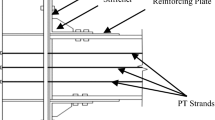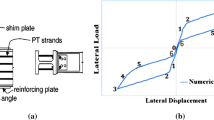Abstract
Post-tensioned (PT) self-centering beam–column connections has been developed for its good seismic performance. Many researchers have investigated its mechanical behavior by numerical or experimental method. Prior researches have indicated that the analysis by elaborate FE models is very time consuming. To overcome this disadvantage, a simplified numerical model was established in this paper. The accuracy of results derived by this model was validated against prior investigations on interior PT connections with top-and-seat angles. Influence of initial PT force on mechanical behavior of PT connection was investigated. The Geometric and material nonlinearities, and strands can be considered in the modeling. A planar steel frame structure was established and hysteretic analysis was conducted. Results indicated that the computational cost can be greatly reduced by this model.
Similar content being viewed by others
References
Angelos S. Tzimas, Athanasios I. Dimopoulos, Theodore L. Karavasilis (2015). “EC8-based seismic design and assessment of self-centering post-tensioned steel frames with viscous dampers.” Journal of Constructional Steel Research, 105, pp. 60–73.
ANSYS user‘s manual. SAS IP inc.; 1998
Garlock Maria M., Ricles James M, Sause Richard (2005). “Experimental Studies of Full-Scale Posttensioned Steel Connections.” Journal of Structural Engineering, 131(3), pp. 438–448.
Garlock Maria M., Ricles James M., Sause Richard (2008). “Influence of design parameters on seismic response of post-tensioned steel MRF systems.” Engineering Structures, 30(4), pp. 1037–1047.
Garlock Maria M., Sause Richard, Ricles, James M. (2007). “Behavior and Design of Posttensioned Steel Frame Systems.” Journal of Structural Engineering, 133(3), pp. 389–399.
Guo Tong, Song Lianglong and Zhang Guodong (2011). “Numerical simulation of the seismic behavior of selfcentering steel beam-column connections with bottom flange friction devices.” Earthquake Engineering and Engineering Vibration, 10(2), pp. 229–238.
George V, Theodore LK, Brian U (2013). “Finite element models and cyclic behavior of self-centering steel posttensioned connections with web hourglass pins.” Eng Struct, 52, pp. 1–16.
Herning G., Garlock M. E. M., and Vanmarcke E. (2011). “Reliability based evaluation of design and performance of steel self-centering moment frames.” Journal of Constructional Steel Research, 67(10), pp. 1495–1505.
Kim H.-J., and Christopoulos C. (2009). “Numerical models and ductile ultimate deformation response of posttensioned self-centering moment connections.” Earthquake Engineering and Structural Dynamics, 38(1), pp. 1–21.
Kim H.-J. and Christopoulos C. (2008). “Friction damped posttensioned self-centering steel moment-resisting frames.” Journal of Structural Engineering, 134(11), pp. 1768–1779.
Lin Y.-C., Sause R., and Ricles J (2013). “Seismic performance of a large-scale steel self-centering momentresisting frame: MCE hybrid simulations and quasi-static pushover tests.” Journal of Structural Engineering, 139(7), pp. 1227–1236.
Lin Y.-C., Sause R., and Ricles J (2013). “Seismic performance of steel self-centering, moment-resisting frame: Hybrid simulations under design basis earthquake.” Journal of Structural Engineering, 139(7), pp. 1227–1236.
Moradi Saber, Alam M. Shahria (2016). “Finite-Element Simulation of Posttensioned Steel Connections with Bolted Angles under Cyclic Loading.” Journal of Structural Engineering, 142(1), pp. 1–15.
Michael Wolski, James M. Ricles, Richard Sause (2009). “Experimental Study of a Self-Centering Beam-Column Connection with Bottom Flange Friction Device.” Journal of Structural Engineering, 135(5), pp. 479–488.
Ricles J. M., Sause R., Peng S. W., Lu L.W. (2002). “Experimental Evaluation of Earthquake Resistant Posttensioned Steel Connections.” Journal of Structural Engineering, 128(7), pp. 850–859.
Ricles James M., Richard Sause, Maria M. Garlock, Chen Zhao (2001). “Posttensioned Seismic-Resistant Connections for Steel Frames.” Journal of Structural Engineering, 127(2), pp. 113–121.
Tsai K.-C., Chou C.-C., Lin C.-L., Chen P.-C., and Jhang S.-J. (2008). “Seismic self-centering steel beam-to-column moment connections using bolted friction devices.” Earthquake Engineering and Structural Dynamics, 37(4), pp. 627–645.
Zhang Ai-lin, Zhang Yan-xia, Li Rui, Wang Zong-yang (2016). “Cyclic behavior of a prefabricated self-centering beam-column connection with a bolted web friction device.” Engineering Structures, 111, pp. 185–198.
Author information
Authors and Affiliations
Corresponding author
Rights and permissions
About this article
Cite this article
Chen, Z., Li, H., Zhao, Z. et al. A simplified numerical model for post-tensioned steel connections with bolted angles. Int J Steel Struct 17, 1487–1494 (2017). https://doi.org/10.1007/s13296-017-1217-6
Received:
Accepted:
Published:
Issue Date:
DOI: https://doi.org/10.1007/s13296-017-1217-6




